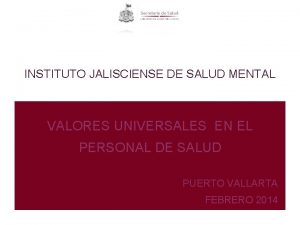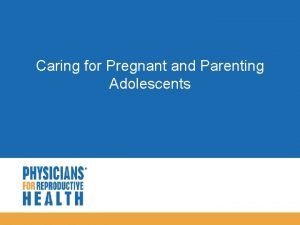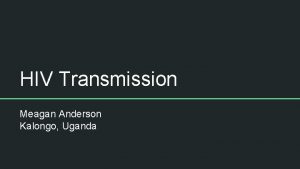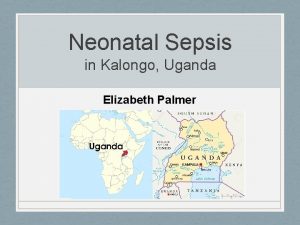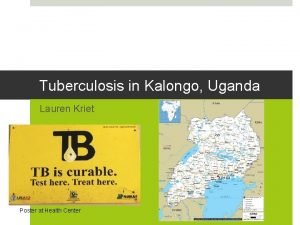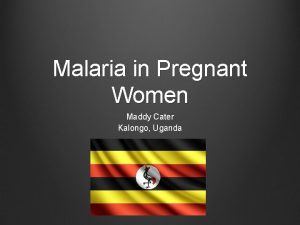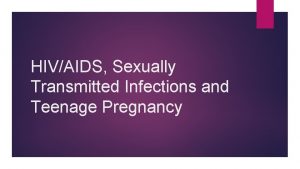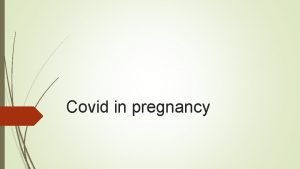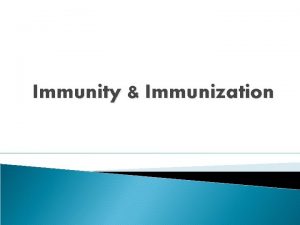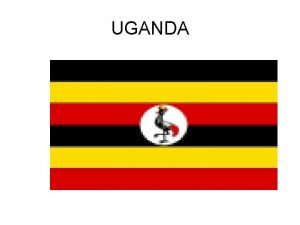HIVAIDs in Pregnancy Kalongo Uganda Clarissa Negrete Specific















- Slides: 15

HIV/AIDs in Pregnancy Kalongo, Uganda Clarissa Negrete

Specific Learning Objectives • Describe how HIV is identified and treated in pregnancy • Identify the measures taken to prevent transmission of HIV from mom to baby • Identify strategies utilized for HIV prevention at the individual, community, and national levels • Identify possible barriers to preventing the spread of HIV

Background Information • Uganda is located in eastern Africa and lies along the equator • Divided into 111 districts and then further divided into counties, sub-counties and parishes (Uganda Bureau of Statistics, 2016) • Agago District • Population of 227, 792 (Dr. Ambrosoli Memorial Hospital, 2016) • HIV/AIDs • Uganda still seen as a high burden country—number of individuals living with HIV increased from 1. 3 -1. 5 million from 2011 -2014 (Republic of Uganda, 2015)

Background Information (Cont’d) • In the Agago district, there was a 7% HIV positivity rate amongst individuals tested in fiscal year 2015 -2016, as opposed to the 5. 6% positivity rate reported for fiscal year 2014 -2015 (Dr. Ambrosoli Memorial Hospital, 2016). • There was a substantial increase in the individuals tested during 2015 -2016 in comparison to 2014 -2015 • Increase in prevalence of HIV seen in Agago district and Uganda can be attributed to the current generation having children • Many individuals currently having children were born to one of the last generations of women who could not adequately prevent spread of HIV from mother to child (P. Akot, personal communication, January 14, 2017) • These women could be attributing to the increase in HIV prevalence because they are tested during pregnancy—may not know they have HIV prior to pregnancy

Description of Clinical Site • St. Mary’s Midwifery Training School is located in Kalongo, which is located in the Agago district of Uganda • St. Mary’s is located next to the Dr. Ambrosoli Memorial Hospital which is a 271 bed facility (Dr. Ambrosoli Memorial Hosptial, 2016) • The hospital campus also contains: antenatal clinic, HIV clinic, maternal waiting center, and various hospital wards from pediatric to surgical View of St. Mary’s Midwifery Training School, Kalongo, Uganda

HIV in Pregnancy • In Kalongo, there were at least 130 documented cases of HIV in pregnancy during the 2015 -2016 fiscal year. About 50 were newly diagnosed with HIV during their pregnancy (Dr. Ambrosoli Memorial Hospital, 2016) • HIV itself is problematic because of its effect on the immune system • The disease can progress to AIDs (CD 4 count of less than 200) making it more difficult for the body to fight off disease opportunistic infections death • HIV is especially problematic in pregnancy which also has a negative impact on the immune system development of opportunistic infections (P. Akot, personal communication, January 14, 2017)

Primary Information Learned • At the antenatal clinic in Kalongo (which is located on the Dr. Ambrosoli Memorial Hospital campus), there is an average of 611 pregnant women diagnosed HIV positive per month. • The HIV test is performed early in first trimester of pregnancy and it also looks at the positivity of other diseases and STIs Antenatal Clinic, Dr. Ambrosoli Memorial Hospital, Kalongo, Uganda

Primary Information Learned • If mother is diagnosed with HIV she is immediately started on antiretroviral therapy • Identified as Option B+, which was implemented by the Ministry of Health in 2014 because it was seen to be more effective in preventing spread of HIV from mom to baby (P. Akot, personal communication, January 15, 2017) • Also started on antibiotic prophylactically to prevent opportunistic infections • Sent home, report in two weeks for drug counseling (may be referred to physician if adverse effects too much to handle) • Mother reports to clinic every month for supplies, takes medication daily (medication provided via Ministry of Health, free of charge to public) • If mother stops reporting to clinic at any point for refills, a home visit is made for counseling to identify barriers to acquiring medication • After baby is born, mother referred to HIV clinic near her, baby is tested for HIV at 6 weeks and again at 1 year (after breastfeeding is complete) to make sure baby is HIV free

Strategies for Prevention • Individual Level: • Use of contraceptives to prevent pregnancy and spread of disease • Encouraged for both partners to get tested before marrying • Monogamous sexual relationships • Community Level: • Village Health Team (VHT) teaches about avoiding the sharing of needles, razors, or other objects which may be contaminated with blood. • Sharing cannot always be prevented so they place an emphasis on boiling in water to properly clean. • VHT also teaches the importance of self -protection when caring for an HIV positive family member

Strategies for Prevention (cont’d) • National Level: • Utilization of billboards countrywide which display importance of HIV testing and prevention • President discusses the importance of decreasing HIV prevalence on a daily basis and how the government is seeking improvement (P. Akot, personal communication, January 15, 2017) • Ministry of Health provides guidelines for treatment and antiretroviral medication to HIV clinics throughout the country • PPE used in hospital settings to prevent spread of HIV

Possible Barriers to Preventing HIV • If ART is followed correctly (as displayed in previous slides), rates of transmission from mom to baby are small to non-existent (P. Akot, personal communication, January 14, 2017) • However, the issue still stands in preventing the spread of HIV amongst adolescents and adults in order to prevent the prevalence of HIV in pregnant women and the possibility of spreading from mom to baby. • While there is becoming less of a stigma surrounding HIV and HIV testing, this could still be contributing to the spread of HIV • Although readily available, contraception is not always utilized, increasing the possibility for spread of HIV • Furthermore, it is not seen as culturally acceptable for women to deny the sexual advances of their husbands; therefore, HIV can still be acquired if men refuse to use condoms or participate in extra-marital affairs and do not utilize condoms (P. Akot, personal communication, January 14, 2017).

Conclusions • Currently, HIV is identified and treatment is begun early in pregnancy in order to prevent spread from mom to baby • Many strategies are already being utilized at the individual, community, and national levels to help prevent the spread of HIV • However, there are still various barriers which may be preventing the desired decrease of HIV transmission • The Village Health Team needs to continue to education on preventing the spread of HIV at the community level • The continued education can further help in eliminating the stigma surrounding HIV • Educate on the importance of testing may also further help eliminate the unknowing transmission of HIV and increase the use of condoms in sexual relationships • A profound barrier which still remains and may be more difficult to overcome is the cultural perceptions of gender obligations in a sexual relationship • Educate on and promote contraception and monogamous sexual relationships • Maybe be most beneficial

Most Profound Clinical Experience • I was able to witness two births during my time in Kalongo • The picture to the right displays a delivery table • The tables had attachable stirrups which would be put in place to utilize lithotomy positioning during labor • It was incredible to watch the women give birth in such a small place—they were very quiet and they were given no medication

Most Profound Cultural Experience • The hospitality I experienced was unparalleled. • We were warmly welcomed everywhere we went, particularly in Kalongo at St. Mary’s Midwifery Training School • The writing on the chalkboard was there all week and one of the lovely students took the time to cook all of our meals during our stay • The two beautiful ladies to the right were my incredible roommates who did everything in their power to make sure I and my classmates were comfortable during our stay

References • Dr. Ambrosoli Memorial Hospital. (2016). Kalongo annual analytical report FY 2015 -2016. Retrieved from file: ///C: /Users/cnegr/App. Data/Local/Microsoft/Windows/INet. Cache/IE/PXX 8 YSFU/Ann ual%20 Analytical%20 Report%20 FY%202015 -16%20 DAMHK%2004012017. pdf • The Republic of Uganda. (2016). The HIV and AIDS Uganda country progress report 2014. Retrieved from file: ///C: /Users/cnegr/App. Data/Local/Microsoft/Windows/INet. Cache/IE/65 MKEU 00/Th e%20 HIV%20 and%20 AIDS%20 Uganda%20 Country%20 Progress%20 Report%202014. pdf • Uganda Bureau of Statistics. (2016). The national population and housing census 2014. Retrieved from file: ///C: /Users/cnegr/App. Data/Local/Microsoft/Windows/INet. Cache/IE/RS 4 JJWXM/201 4%20 National%20 Census%20 Main%20 Report. pdf
 Implantation bleeding pictures
Implantation bleeding pictures Cualidades de un expositor
Cualidades de un expositor Kate del castillo negrete trillo
Kate del castillo negrete trillo Guadalajara en un llano
Guadalajara en un llano Valores universales lucía amanda negrete lares
Valores universales lucía amanda negrete lares Objectives of teenage pregnancy
Objectives of teenage pregnancy Agatha mary clarissa christie
Agatha mary clarissa christie To where does belinda travel in canto
To where does belinda travel in canto Clarissa baldotto
Clarissa baldotto Clarissa cabrera
Clarissa cabrera Bernoulli locke
Bernoulli locke Clarissa's speech canto 5
Clarissa's speech canto 5 Clarissa margaret boehmer
Clarissa margaret boehmer Clarissa lyons
Clarissa lyons Clarissa jacobson
Clarissa jacobson Clarissa morawski
Clarissa morawski




